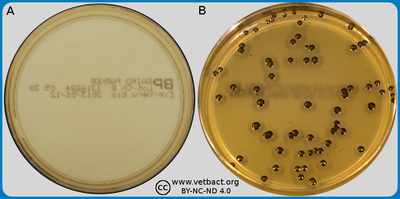Baird-Parker agarThe figure shows two BP agar plates. Bacteria has not been cultivated on plate A, but on plate B, Staphylococcus aureus subsp. aureus have been cultivated. Note the black colour of the colonies and the double zone around the colonies. - Click on the image to enlarge it. Image: Ingrid Hansson (SLU), Lise-Lotte Fernström (SLU) & Karl-Erik Johansson (SLU).
ApplicationsBaird-Parker agar (BP agar) is a selective medium for identification and enumeration of coagulase positive Staphylococcus spp. BP agar is used for detection of Staphylococcus aureus in food, dairy products and cosmetic products. Cultivation is performed after surface streaking and at 37°C. Baird Parker agar supplemented with acriflavin can be used to differentiate between S. aureus, which is able to grow in the presence of acriflavin, from other DNase positive, hemolytic staphylococci (S. intermedius group). The medium contains:
Other comments:Coagulase positive staphylococci form black colonies, since sodium tellurite is reduced to telluride, which is a black insoluble substance. Lecithinase and lipase activity of coagulase positive staphylococci result in a clear and an opaque zone around the colonies. Updated: 2018-05-09. |

